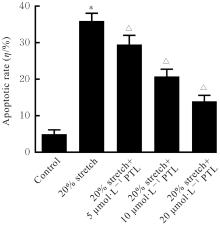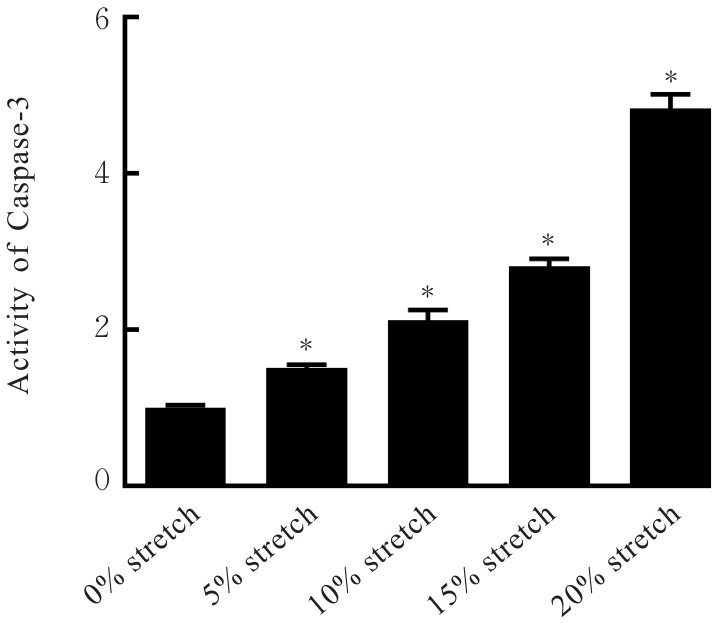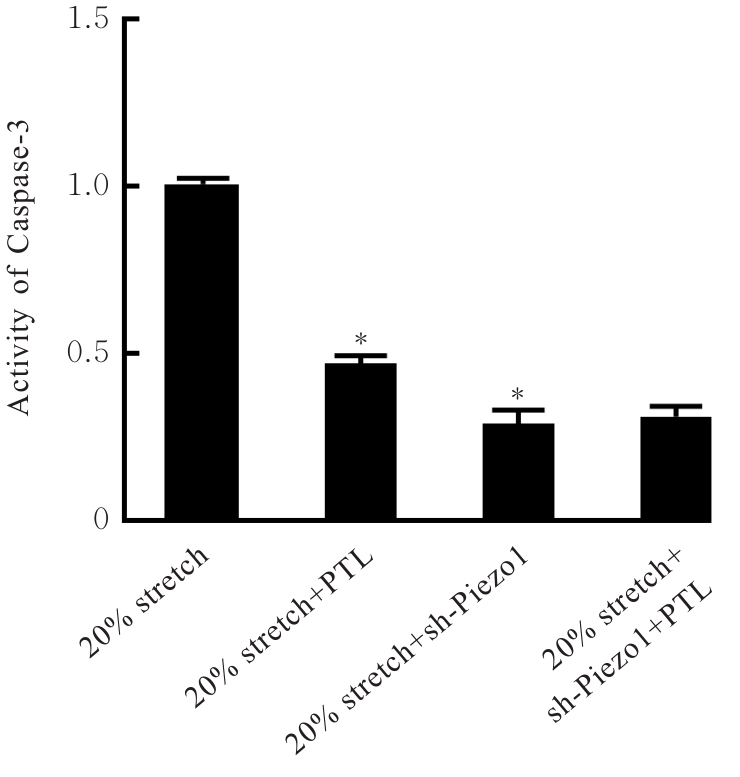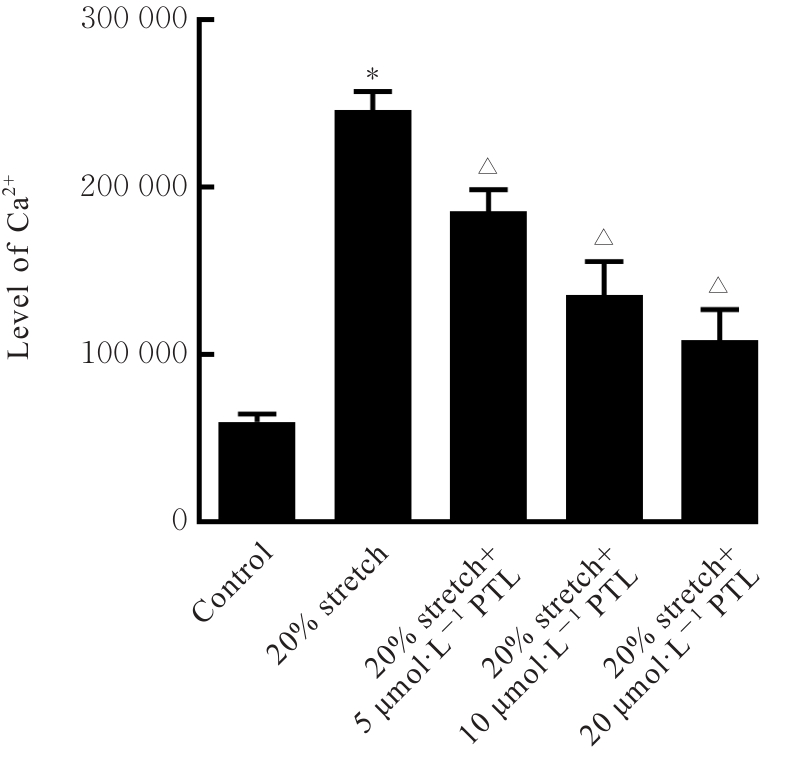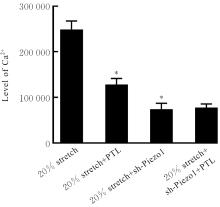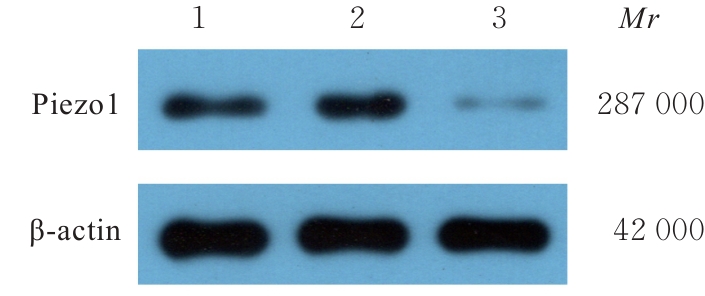Journal of Jilin University(Medicine Edition) ›› 2024, Vol. 50 ›› Issue (6): 1621-1631.doi: 10.13481/j.1671-587X.20240616
• Research in basic medicine • Previous Articles
Effect of parthenolide on apoptosis of chondrocyte under mechanical stretch stress by inhibiting Piezo1 expression and its mechanism
Xuan MA1,Kaixiang YANG2,Hai DENG2,Yucheng HUANG1( )
)
- 1.Department of Orthopedic Trauma,NO. 4 Hospital,Wuhan City,Hubei Province,Wuhan 430030,China
2.Department of Articular Surgery,NO. 4 Hospital,Wuhan City,Hubei Province,Wuhan 430030,China
-
Received:2023-12-31Online:2024-11-28Published:2024-12-10 -
Contact:Yucheng HUANG E-mail:ehyc836@163.com
CLC Number:
- R681.3
Cite this article
Xuan MA,Kaixiang YANG,Hai DENG,Yucheng HUANG. Effect of parthenolide on apoptosis of chondrocyte under mechanical stretch stress by inhibiting Piezo1 expression and its mechanism[J].Journal of Jilin University(Medicine Edition), 2024, 50(6): 1621-1631.
share this article
| 1 | EMAMI A, NAMDARI H, PARVIZPOUR F, et al. Challenges in osteoarthritis treatment[J]. Tissue Cell, 2023, 80: 101992. |
| 2 | YUE L D, BERMAN J. What is osteoarthritis?[J]. JAMA, 2022, 327(13): 1300. |
| 3 | FANG T S, ZHOU X H, JIN M C, et al. Molecular mechanisms of mechanical load-induced osteoarthritis[J]. Int Orthop, 2021, 45(5): 1125-1136. |
| 4 | LAI A, COX C D, CHANDRA SEKAR N, et al. Mechanosensing by Piezo1 and its implications for physiology and various pathologies[J]. Biol Rev Camb Philos Soc, 2022, 97(2): 604-614. |
| 5 | LIU Y L, TIAN H T, HU Y X, et al. Mechanosensitive Piezo1 is crucial for periosteal stem cell-mediated fracture healing[J]. Int J Biol Sci, 2022, 18(10): 3961-3980. |
| 6 | CAI G H, LU Y H, ZHONG W J, et al. Piezo1-mediated M2 macrophage mechanotransduction enhances bone formation through secretion and activation of transforming growth factor-β1[J]. Cell Prolif, 2023, 56(9): e13440. |
| 7 | 陈墨龙, 陈 万, 唐康来. 过度机械拉伸应力通过Piezo1介导肌腱细胞凋亡的作用及机制研究[J]. 陆军军医大学学报, 2023, 45(10): 1040-1049. |
| 8 | WANG S Y, LI W W, ZHANG P F, et al. Mechanical overloading induces GPX4-regulated chondrocyte ferroptosis in osteoarthritis via Piezo1 channel facilitated calcium influx[J]. J Adv Res, 2022, 41: 63-75. |
| 9 | ZHU S P, SUN P, BENNETT S, et al. The therapeutic effect and mechanism of parthenolide in skeletal disease, cancers, and cytokine storm[J]. Front Pharmacol, 2023, 14: 1111218. |
| 10 | LIU Q, ZHAO J, TAN R, et al. Parthenolide inhibits pro-inflammatory cytokine production and exhibits protective effects on progression of collagen-induced arthritis in a rat model[J]. Scand J Rheumatol, 2015, 44(3): 182-191. |
| 11 | WILLIAMS B, LEES F, TSANGARI H, et al. Assessing the effects of parthenolide on inflammation, bone loss, and glial cells within a collagen antibody-induced arthritis mouse model[J]. Mediators Inflamm, 2020, 2020: 6245798. |
| 12 | DELL’ISOLA A, ALLAN R, SMITH S L, et al. Identification of clinical phenotypes in knee osteoarthritis: a systematic review of the literature[J]. BMC Musculoskelet Disord, 2016, 17(1): 425. |
| 13 | CHANG S H, MORI D, KOBAYASHI H, et al. Excessive mechanical loading promotes osteoarthritis through the gremlin-1-NF-κB pathway[J]. Nat Commun, 2019, 10(1): 1442. |
| 14 | ZHAO J Y, LI C J, QIN T, et al. Mechanical overloading-induced miR-325-3p reduction promoted chondrocyte senescence and exacerbated facet joint degeneration[J]. Arthritis Res Ther, 2023, 25(1): 54. |
| 15 | 伍伟挺, 黎润光, 曹生鲁, 等. 过度周期性机械应力刺激可引起软骨细胞炎症反应及凋亡[J]. 中国组织工程研究, 2021, 25(29): 4608-4613. |
| 16 | YU J L, LIAO H Y. Piezo-type mechanosensitive ion channel component 1 (Piezo1) in human cancer[J]. Biomed Pharmacother, 2021, 140: 111692. |
| 17 | GAO W, HASAN H, ANDERSON D E, et al. The role of mechanically-activated ion channels Piezo1, Piezo2, and TRPV4 in chondrocyte mechanotransduction and mechano-therapeutics for osteoarthritis[J]. Front Cell Dev Biol, 2022, 10: 885224. |
| 18 | 闫 亮, 姜 金, 万 浪, 等. Piezo机械敏感性离子通道研究现状及其在骨与关节组织的研究进展[J]. 中国医学物理学杂志, 2018, 35(8): 962-967. |
| 19 | TIWARY S, NANDWANI A, KHAN R, et al. GRP75 mediates endoplasmic reticulum-mitochondria coupling during palmitate-induced pancreatic β-cell apoptosis[J]. J Biol Chem, 2021, 297(6): 101368. |
| 20 | LI Y, LI H Y, SHAO J, et al. GRP75 modulates endoplasmic reticulum-mitochondria coupling and accelerates Ca2+-dependent endothelial cell apoptosis in diabetic retinopathy[J]. Biomolecules, 2022, 12(12): 1778. |
| 21 | 朱芳晓, 莫汉有, 陈 建, 等. 小白菊内酯不同给药途径对兔膝骨关节炎的实验研究[J]. 中国骨质疏松杂志, 2015, 21(10): 1254-1257. |
| [1] | Siqi LI,Guangdao CHEN,Qiyi ZENG. Improvement effect of chrysophanol on hydrogen peroxide-induced apoptosis of EA. hy926 cells and its mechanism [J]. Journal of Jilin University(Medicine Edition), 2024, 50(6): 1512-1518. |
| [2] | Jingshun ZHANG,Yinggang ZOU,Lianwen ZHENG. Effect of over-expression SLC7A5 on apoptosis of ovarian granulosa cells in rats and its mechanism [J]. Journal of Jilin University(Medicine Edition), 2024, 50(6): 1526-1534. |
| [3] | Yuxiao SHI,Meilan LIU,Meilin ZHU,Feng WEI. Effects of 5-Aza-CdR on autophagy and apoptosis of papillary thyroid cancer cells in subcutaneous xenograft tumor tissue of nude mice and its mechanism [J]. Journal of Jilin University(Medicine Edition), 2024, 50(5): 1330-1338. |
| [4] | Dandan YANG,Jiaoyang CHEN,Xinheng WANG,Zetong ZHAO,Ying PAN,Baigong XUE,Changzhao GAO. Improvement of isolation and culture methods for primary chondrocytes of neonatal rats [J]. Journal of Jilin University(Medicine Edition), 2024, 50(5): 1438-1449. |
| [5] | Yongjing YANG,Tianyang KE,Shixin LIU,Xue WANG,Dequan XU,Tingting LIU,Ling ZHAO. Synergistic sensitization of apatinib mesylate and radiotherapy on hepatocarcinoma cells invitro [J]. Journal of Jilin University(Medicine Edition), 2024, 50(4): 1009-1015. |
| [6] | Guoxing YU,Xin ZHANG,Hengwei DU,Bingjie CUI,Na GAO,Cuilan LIU,Jing DU. Effect of urolithin C on proliferation, apoptosis and autophagy of human acute myeloid leukemia HL-60 cells and its mechanism [J]. Journal of Jilin University(Medicine Edition), 2024, 50(4): 908-916. |
| [7] | Chao LIANG,Juanjuan DAI,Ning ZHOU,Dandan WANG,Jie ZHAO,Di AN,Yan WU. Effect of oridonin on cell proliferation, migration, and apoptosis of human nasopharynx carcinoma HONE-1 cells [J]. Journal of Jilin University(Medicine Edition), 2024, 50(4): 917-924. |
| [8] | Tengfei WANG, Feng CHEN, Ling QI, Ting LEI, Meihui SONG. Inhibitory effect of D-limonene on proliferation of glioblastoma cells and its mechanism [J]. Journal of Jilin University(Medicine Edition), 2024, 50(3): 647-657. |
| [9] | Jiacai FU,Lingsha QING,Lu YANG,Meihui SONG,Xianying ZHANG,Xiaocui LIU,Fengjin LI,Ling QI. Inhibitory effect of Schisandrin B on proliferation of pancreatic cancer Pan02 cells and its mechanism [J]. Journal of Jilin University(Medicine Edition), 2024, 50(3): 638-646. |
| [10] | Lin CHEN,Limin YAN,Huaijie XING,Min CHEN,Xiaoyan LI,Chaosheng ZENG. Improvement effect of Xuebijing on brain tissue injury and Th17/Treg immune imbalance in cerebrospinal fluid in NMDA receptor encephalitis model mice [J]. Journal of Jilin University(Medicine Edition), 2024, 50(3): 697-707. |
| [11] | Linru WANG,Jing ZHANG,Dongchan ZHAO,Jinjun WANG,Wenxian HU. Effect of silencing FOXO1 gene on autophagy and apoptosis of human aortic vascular smooth muscle cells [J]. Journal of Jilin University(Medicine Edition), 2024, 50(2): 431-441. |
| [12] | Donghong CAI,Qing LI,Lingling KE,Huiya ZHONG,Qilong JIANG,Han ZHANG,Yafang SONG. Expression of mitophagy and apoptosis related genes in peripheral blood mononuclear cells of patients with myasthenia gravis and its clinical diagnosis value [J]. Journal of Jilin University(Medicine Edition), 2024, 50(2): 481-488. |
| [13] | Huijuan SONG,Zhenhua XU,Dongning HE. Effect of apolipoprotein C1 expression on proliferation and apoptosis of human liver cancer HepG2 cells and its mechanism [J]. Journal of Jilin University(Medicine Edition), 2024, 50(1): 128-135. |
| [14] | Yaxin LIU,Jian LIU,Zhen LI,Zhanhong CAO,Haonan BAI,Yu AN,Xingyu FANG,Qing YANG,Hui LI,Na LI. Inhibitory effect of royal jelly acid on proliferation of human colon cancer SW620 cells and its network pharmacological analysis [J]. Journal of Jilin University(Medicine Edition), 2024, 50(1): 150-160. |
| [15] | Yan WANG,Xiaohui LI,Yao JI,Lili CUI,Yujie CAI. Differential effects of APOE polymorphism in neurotoxicity-responsive astrocytes induced by inflammatory factor [J]. Journal of Jilin University(Medicine Edition), 2024, 50(1): 33-41. |
|
||










